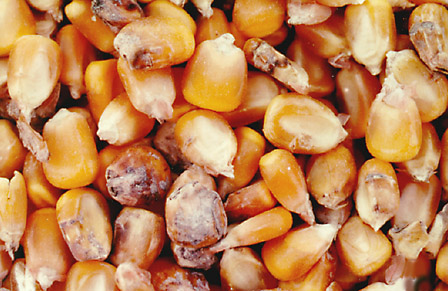
Source: Purdue University
Symptoms:
Silk-cut is the embedment of silks in ruptured areas on tips of kernels or occasionally in the sides of kernels between kernel rows.
Cause:
Unknown, but may be caused by irregular growth of the pericarp around unpollinated silks. Even on an ear that appears to be fully pollinated, as many as 10% of the ovules are not fertilized. Pollinated silks die and dry up, but silks attached to unpollinated ovules remain viable for an extended period of time. The viable silks push against the developing pericarp of kernels, causing the pericarp to rupture. Silk-cut results in the rupture of the pericarp and may allow infection by ear-rotting and saprophytic fungi. This kernel defect is often discussed in conjunction with popped kernels. Associated with stressful conditions following pollination. Silk cut is generally regarded as an oddity that rarely occurs in commercial hybrids in the Corn Belt and occasionally occurs at significant levels in seed corn inbreds. However, silk-cut symptoms have been reported quite frequently in areas of south Texas prone to late-season drought stress.
Management:
Scout fields to determine the extent of this kernel injury. Harvest in a timely way and dry grain promptly. Provide good storage conditions. Market affected grain promptly. According to the Federal Grain Inspection Service, kernels which contain any amount of mold in the silk cut are damaged. Kernels which contain clean silk cuts and are otherwise undamaged are sound kernels.
References:
Anonymous. 2002. Silk cut. USDA FGIS/Education and Outreach Visual Reference Library – Corn. Available at http://www.gipsa.usda.gov/vri/corn_8.aspx [URL verified 3/28/2019].
Odvody, G.N., N. Spencer, and J. Remmers. 1997. A Description of Silk Cut, a Stress-Related Loss of Kernel Integrity in Preharvest Maize. Plant Disease 81 (5):439-444. Available at http://apsjournals.apsnet.org/doi/pdf/10.1094/PDIS.1997.81.5.439 [URL verified 3/28/2019].
Vincelli, Paul, Chad Lee, and Ric Bessin. 2010. Some Unusual Kernel Injuries. Kentucky Pest News, Univ of Kentucky Extension.
White, Donald G. (ed.). 1999. Noninfectious or Abiotic Diseases. in Compendium of Corn Diseases (3rd Edition). APS Press, The American Phytopathological Society.
